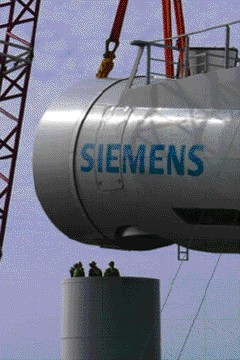
Siemens AG Chief Executive Officer Joe Kaeser said he’s prepared to make acquisitions to exploit a boom in the US natural-gas industry that will eclipse demand in Europe, where the economy is still struggling to rebound.
As more facilities spring up across the US to extract, transport and store shale oil and gas won from hydraulic fracturing, or fracking, Siemens must keep up to expand its own offering, Kaeser said in an interview yesterday in Frankfurt. Supplying more gas and oil equipment would give the company a lock on lucrative, long-term service contracts, he said.
“Our firepower is huge, obviously, if you look at the liquidity, the cash we generate and the rating we’ve got,” said the CEO, a Siemens veteran who was promoted from finance chief in August last year. “There are great businesses within Siemens which are readily available now to integrate acquisitions. There are others which need to get their house in order first and then we can consider it.”
Siemens displayed its drive to participate in the natural- gas frenzy when the company sought to outbid General Electric Co. last month for energy assets of Alstom SA before the US rival prevailed with a bid favored by the French government and Alstom’s board. Kaeser predicted that the US will buy more gas-powered turbines in a single year than Europe in a decade, and that consolidation in the industry will benefit all players.
To beef up its energy business, Siemens in May agreed to buy most of Rolls-Royce Holdings Plc’s energy assets for $1.3billion. Before that deal, Siemens had been evaluating a bid for Dresser-Rand Group Inc., which also makes turbines and compressors used in gas extraction, people familiar with the discussions said previously.
Analysts have cited other oil and gas service specialists Chart Industries Inc., Dril-Quip Inc., Weatherford International Ltd. and Tesco Corp. as attractive targets for large industrial companies such as Munich-based Siemens. While Kaeser declined to comment on potential targets, process automation offerings for the gas and oil industry are “a desired area to acquire,” he said, citing technology around liquefied natural gas.
Kaeser became CEO after predecessor Peter Loescher slashed a profit target five times in his six-year tenure. The arrival of Kaeser and the bet that he can tackle the sprawling 85 billion-euro company has helped boost shares of Siemens 14% since he took over. While that beat GE’s 8 percent gain in the same period, it lagged behind the 18 percent increase of Germany’s DAX benchmark index.
Fracking — the process of blasting water, sand and chemicals into miles-deep shale rock to extract fuels — has helped push US natural gas production to new highs in each of the past seven years, according to the Energy Information Administration. North American oil and gas companies spent $168.2billion on exploration and production last year, more than double 2009, data compiled by Bloomberg show.
In the $17billion takeover battle for Alstom’s energy assets, both GE and Siemens primarily wanted to acquire the French company’s gas turbine-making and -servicing business to meet surging demand from the fracking industry.
“Our products are good, but our installed base is not that great,” Kaeser said yesterday. “If you’re not in the installed base it’s hard to get it in, because no one takes stuff out and puts your stuff in, there’s just too much at risk.”
GE had a 49% global market share of new orders in gas turbines in 2013, compared with Siemens’s 23%, Credit Suisse estimated Feb. 11.
In order to target key customers, Siemens has appointed Lisa Davis, a former Royal Dutch Shell Plc executive, to lead its energy operations. The 50-year-old will be based in Houston, a novelty in a company whose senior management remains firmly rooted in Germany. Siemens generated 14% of its revenue in the US last year, compared with 54% from Europe.
Kaeser has said he wants to build Siemens around electrification and digitization and has begun undoing a corporate structure set up by his predecessor to make the company of about 360,000 employees and annual sales of 66 billion euros more responsive to market trends. The company has 60 sub-units that make products including trains, gas turbines, medical scanners and factory-automation gear.
While some industrial segments are prone to cycles, both Siemens and GE anticipate steady growth in energy demand, and therefore in the equipment needed to supply it. GE CEO Jeffrey Immelt has said he expects underlying demand for electricity to almost to double by 2030.
The focus on North American growth comes as Europe remains stagnant, according to Kaeser, who said calling a recovery in the region is premature.
“If we have just stopped the bleeding, is that a recovery?,” Kaeser said. ‘If demand is elsewhere in the world, we have to go where demand is.’’
Recommended for you
